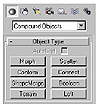| ISO 9000 | ISO 14000 |
 GMP Consulting |
Modeling at the editable mesh level has some distinct advantages and some disadvantages. But first, you must understand that, in order to be working at this level to begin with (the editable mesh level), you must be working with a piece of geometry whose modifier stack has been completely collapsed. This is important, because working at this level of the geometry prevents you from going back and adjusting the parameters of any previously applied modifiers. Creating Models with Compound ObjectsCompound objects are special models that are made up of two or more existing models. The compound objects are found on the Create tab of the Command Panel. Compound objects serve special purposes in the modeling tool bag of tricks. Besides the fact that they require more than one object to complete their task, the end results of compound objects are usually models that would be very difficult to create with standard mesh-editing tools. Table 4.4 lists the compound objects and their uses.
Understanding Compound ObjectsThe technical concept behind a compound object is, of course, the use of two or more pieces of geometry to create a new object. Beyond that, what are some of the possible uses of the models themselves? Let’s look at a couple of specific examples of using compound objects. Compound Objects as Problem Solvers Compound objects are problem solvers because, by their nature, the types of geometry that these tools create can often be used to solve tough modeling issues. For example, if you need geometry that has a very stretched, taut-skin look, you can use the Connect compound object to achieve the effect. Let’s take a look.
You will see that new geometry has been created and spans the holes in each of the objects (as seen in Figure 4.9).
To experiment further, adjust the Tension and Segment settings to see how increasing or decreasing the complexity of the compound object’s settings controls its appearance. Using this method has saved the time it would have taken to model a sinewy-looking piece of geometry. Additionally, you still have the ability to change the operands and even animate them at the sub-object level. (There’s more detail on Connect later in this chapter.) Compound Objects as Time Savers A good example of saving time with a compound object uses the ShapeMerge object. In this example, we will be accomplishing two tasks at once. The first task, in our project, will be to model a door opening in the side of an airplane. The second task will be to model the door that goes in that opening. We can complete both of these tasks by using ShapeMerge.
© 2000, Frol (selection, edition, publication) |
||||||||||||||||||||||||||||||||||||||||||||||||||||||||||
|
|




